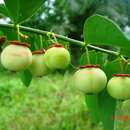en
names in breadcrumbs


Katuk (Sauropus androgynus) or “Sweet Leaf Bush” is another amazing perennial plant that grows with minimum effort. Itproduces nutritious high 6.4% protein leaves that taste like peas. It is one of the most popular leaf vegetables in South Asia and Southeast Asia and is notable for high yields and flavor. The shoot tips have been sold astropical asparagus. In Vietnam, the locals cook it with crab meat, minced pork or dried shrimp to make soup. In Malaysia, it is commonly stir-fried with egg or dried anchovies. The flowers and small purplish fruits of the plant have also be eaten.
Katuk (Sauropus androgynus) or “Sweet Leaf Bush” is another amazing perennial plant that grows with minimum effort. Itproduces nutritious high 6.4% protein leaves that taste like peas.
Sauropus androgynus, also known as katuk, star gooseberry, or sweet leaf, is a shrub grown in some tropical regions as a leaf vegetable.
Its multiple upright stems can reach 2.5 meters high and bear dark green oval leaves 5–6 cm long.
It is a good source of vitamin K. However, a study has suggested that excessive consumption of juiced Katuk leaves (due to its popularity for body weight control in Taiwan in the mid '90s) can cause lung damage, due to its high concentrations of the alkaloid papaverine.[4]
It also has high level of provitamin A carotenoids, especially in freshly picked leaves, as well as high levels of vitamins B and C, protein and minerals. The more the leaves mature, the higher the nutrient content of the leaves.[5]
It is common in evergreen forest and cultivated up to 1,300 m.[6]
It is one of the most popular leafy vegetables in South and Southeast Asia and is notable for high yields and palatability.[7]
In Indonesia, the flowers, leaves, and small purplish fruits of Sauropus androgynus has been consumed and used traditionally since ancient times by the Javanese and Sundanese ethnic groups as the alternative medicine in a form of Jamu (traditional concoction native to Java island, originally formulated by the Javanese) to improve the circulation of blocked breast milk for breastfeeding mothers.[8] Interestingly, according to modern research findings on the efficacy of this herb, indicates that the extract of the Sauropus androgynus leaf increases the expression of prolactin and oxytocin genes 15 to 25 times in breastfeeding mice.[9]
In Malaysia, it is commonly stir-fried with egg or dried anchovies.
In Vietnam, the shoot tips have been sold in cuisine and used similarly like the asparagus; the locals usually cook it with crab meat, minced pork or dried shrimp to make a soup.
Consumption of Sauropus androgynus has been reported as being associated with bronchiolitis obliterans.[10] [11]
The leaves are safe to eat in large quantities only after being cooked as heat seems to denature the toxin.[12]
Sauropus is a good source of β-carotene α- and β-carotenes are partly metabolized into vitamin A. It is rich in Vitamin C providing more than 100% of the Daily Value (DV) per 100 g serving of (288% DV), Iron (23% DV) and Zinc (10% DV).[13] However, the high levels of polyphenols, such as tannin, inhibit the absorption of Zn and Fe.
Sauropus androgynus, also known as katuk, star gooseberry, or sweet leaf, is a shrub grown in some tropical regions as a leaf vegetable.
Its multiple upright stems can reach 2.5 meters high and bear dark green oval leaves 5–6 cm long.
It is a good source of vitamin K. However, a study has suggested that excessive consumption of juiced Katuk leaves (due to its popularity for body weight control in Taiwan in the mid '90s) can cause lung damage, due to its high concentrations of the alkaloid papaverine.
It also has high level of provitamin A carotenoids, especially in freshly picked leaves, as well as high levels of vitamins B and C, protein and minerals. The more the leaves mature, the higher the nutrient content of the leaves.
It is common in evergreen forest and cultivated up to 1,300 m.